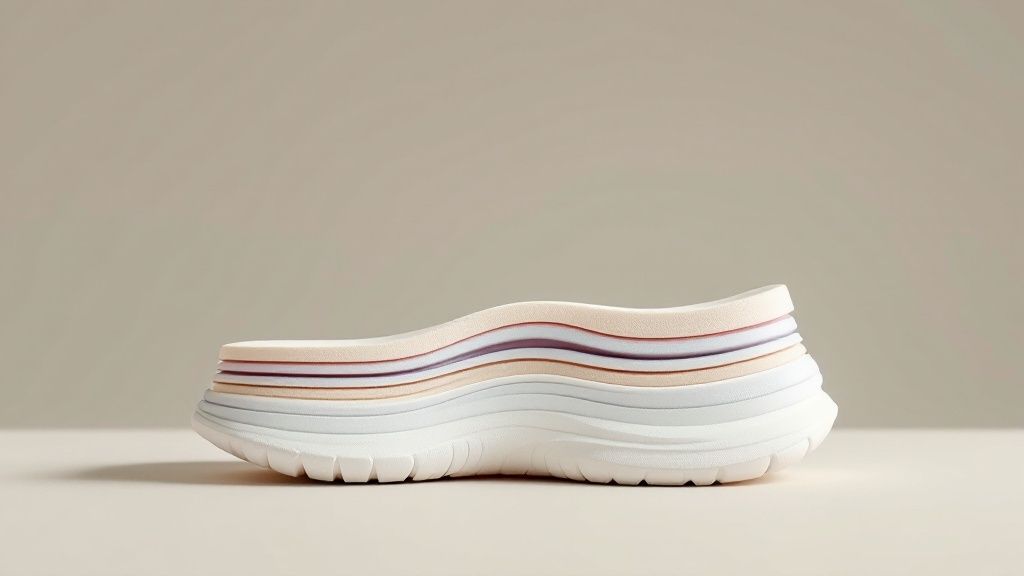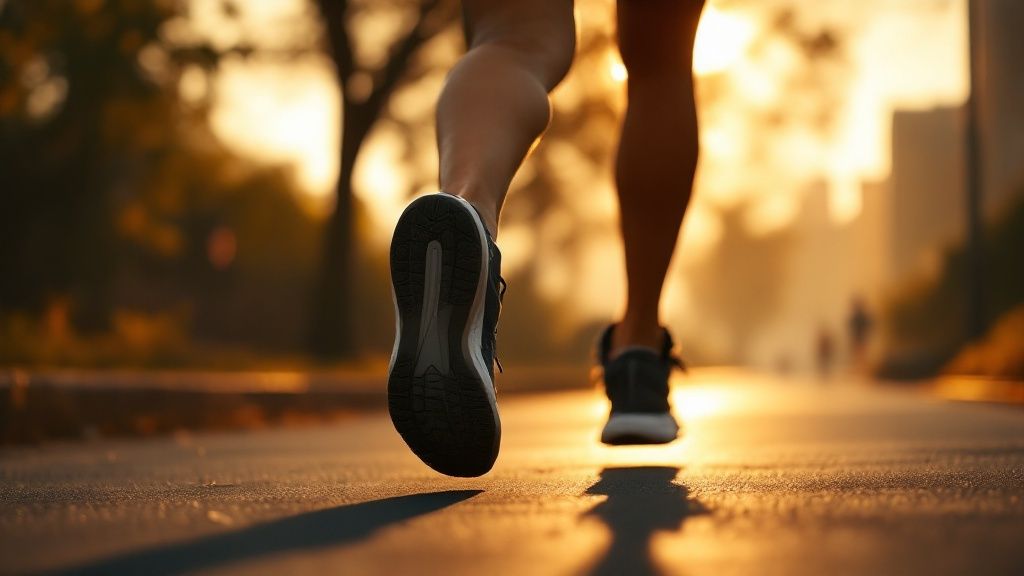Your Ultimate Guide to Running Shoes for Beginners: Edition 2
- Flourish Everyday Health And Fitness

- Oct 5
- 7 min read
Updated: Oct 10
One of the hardest parts of starting a running routine is having to brave a sports store to get your running shoes. "Your Ultimate Guide to Running Shoes for Beginners: Edition 2" will inform you of what you should be looking for and why. Now that you have made this fantastic decision for your health, your most important piece of gear, other than motivation, is the right pair of running shoes for beginners.
The best pairs offer a crucial blend of cushioning, support, and durability, setting you up for a consistent, injury-free journey from the start. This guide is your roadmap to finding that perfect first pair without the guesswork.
Introduction: Your First Step to Becoming a Runner
Before you hit the pavement, your most critical decision is choosing the right footwear. It's easy to feel overwhelmed by the sheer number of brands and confusing technical terms. However, understanding the basics will empower you to make an informed choice.
Proper footwear is a direct investment in injury prevention. Running shoes are specifically built to absorb impact, guide your unique foot motion, and provide a comfortable experience that makes you want to run again. A good pair helps you avoid common beginner issues like blisters, shin splints, and knee pain.

In This Guide, You Will Find:
1. How to Decode Running Shoe Technology
Stepping into the world of running shoes can feel like learning a new language with terms like "midsole," "heel drop," and "pronation." Understanding these core components is key to seeing past marketing hype and choosing a shoe that genuinely meets your needs.
The engine of any running shoe is the midsole, the layer of foam between the outsole (the rubber bottom) and your foot. It acts as the shoe's suspension system, providing cushioning to absorb the shock of each stride. Foams vary from soft and plush to firm and responsive.
Cushioning and Support Systems
Support in running shoes is categorized based on how much it corrects for "pronation," or the natural inward roll of your foot upon landing.
Neutral Shoes: Designed for runners with a balanced gait. They offer cushioning without features intended to correct foot motion.
Stability Shoes: Provide moderate support for "overpronators," whose ankles roll too far inward. They often use firmer foam on the inner side to guide the foot.
Motion Control Shoes: Offer maximum support for severe overpronators, built to prevent excessive inward rolling.
Finding the right shoe is about balancing these elements to match your unique biomechanics.
Understanding Key Shoe Specs
Another key term is heel-to-toe drop, the height difference between the heel and the forefoot (measured in millimeters).
A higher drop (10-12mm) is common in traditional shoes and can reduce strain on the Achilles tendon, making it a safe choice for many beginners. A lower drop (0-8mm) promotes a more natural, midfoot landing but may require a gradual adjustment period.
The outsole is the durable rubber on the bottom that provides traction and protects the midsole. The global running shoe market is projected to grow from $15.22 billion in 2023 to $21.89 billion by 2033, driven by such technological innovations (Source: Market.us, 2023).
2. A Practical Guide to Finding Your Perfect Fit
The most important factor in choosing a shoe is how it fits your unique foot. An improper fit can quickly lead to blisters, discomfort, and injuries, derailing your new running habit.
Shop for shoes in the afternoon or evening, as your feet naturally swell throughout the day. Trying on shoes when your feet are at their largest ensures a comfortable fit when you're actually running.

Key Steps for a Perfect Fit
Bring Your Running Socks: The thickness of your socks affects the fit, so always try on shoes with the socks you'll wear for running.
Check the Length: You should have about a thumb's width (roughly half an inch) of space between your longest toe and the end of the shoe. This prevents your toes from hitting the front.
Assess the Width: The shoe should be snug in the midfoot and heel but allow your toes to wiggle and spread. If your foot bulges over the side, you need a wider size.
The ideal fit provides a secure lockdown in the heel to prevent slipping and a roomy toe box for comfort. The shoe should feel "just right" in the store—not too tight and not too loose.
3. Top Athletic Shoe Reviews: Men's Edition
For new runners, the goal is to find a shoe that balances cushioning, support, and durability at a reasonable price. Here are some top-performing models for men that deliver a reliable and comfortable experience.
Individual Brand Shoe Reviews
Brooks Ghost: A popular neutral shoe known for its soft cushioning and smooth ride. It’s a dependable workhorse that offers consistent comfort.
Hoka Clifton: Famous for its maximalist cushioning, the Clifton provides a plush, protective feel while remaining surprisingly lightweight. It's excellent for minimizing joint impact.
ASICS GEL-Kayano: A legendary stability shoe that provides gentle guidance for overpronators without feeling overly rigid. It's known for its durability.
New Balance Fresh Foam X 860: This model offers reliable stability with a soft, cushioned feel, making it a great choice for runners whose feet tend to roll inward.
Nike Downshifter: An excellent budget-friendly option that provides ample cushioning and a comfortable fit for new runners. For more details, see our review of the Nike Men's Downshifter 13 Road Running Shoes.
The best shoe for a beginner is often the one that feels most comfortable and disappears on your foot. Focus on a great fit and balanced feel over flashy tech. (Source: Outside Magazine, 2023)

4. Top Athletic Shoe Reviews: Women's Edition
Women's running shoes are engineered for female biomechanics, often featuring a wider forefoot and narrower heel. The key is to find a comfortable, supportive, and valuable model.
Individual Brand Shoe Reviews
Brooks Adrenaline GTS: A long-time favorite that blends soft cushioning with reliable support. Its GuideRails system gently guides your body's natural motion path.
Saucony Guide: Known for its smooth, stable ride, this shoe offers a touch of guidance that helps build confidence without being intrusive.
Adidas Ultraboost: A popular choice for its springy, responsive cushioning and stylish design. It transitions well from a run to everyday activities. See our review of the Adidas Women's Ultraboost 10 Sustain Sneaker.
You don’t need the most expensive shoe to have a great experience. Budget-friendly models like the Adidas Questar 3 (around $75) perform exceptionally well. Lab tests show it requires 5.3% less force to bend than the average shoe, offering a more flexible ride (Source: RunRepeat, 2024).
5. Informative Health Information: Injury Prevention
Your running shoes are your first line of defense against injury. They are designed to absorb the impact of each foot strike, protecting your joints from common ailments like shin splints and runner's knee.
The Lifespan of Your Running Shoes
Even the best shoes wear out. The midsole foam compresses over time and loses its ability to absorb shock. Continuing to run in worn-out shoes is a common mistake that can lead to injury.
As a rule, replace your running shoes every 300 to 500 miles. For a beginner running 15 miles a week, this means a new pair every five to eight months.
Recognizing Signs of Wear and Tear
Worn Outsoles: If the tread on the bottom is smooth, the shoe has lost its grip and structural integrity.
Midsole Creases: Deep wrinkles in the side foam indicate the cushioning is permanently compressed.
Loose Fit: If the upper material has stretched and your foot slides around, the shoe no longer provides adequate support.
For more on staying healthy, read our guide on how to prevent running injuries.
6. Comparison Reviews and Common Questions
Here, we compare different wellness approaches and answer common questions to help you start your running journey with confidence.
Comparison of Well-being Trends: Shoe Rotation vs. Single Pair
Single Pair Method: Simple and cost-effective initially. The runner uses one pair of shoes for all runs until they wear out.
Shoe Rotation Method: Involves alternating between two or more different pairs of shoes. Research suggests this method can reduce the risk of running-related injuries by up to 39% by varying the stresses on the body (Source: Malisoux et al., 2015, Scandinavian Journal of Medicine & Science in Sports). The foam also has more time to decompress between runs, potentially extending the life of each pair.
Frequently Asked Questions
Can I just use my gym trainers?
It's not recommended. Running shoes are specifically designed to absorb the high-impact, repetitive forward motion of running. Gym trainers are built for lateral stability and are not suited for the demands of road running.
How long do running shoes last?
Generally, 300 to 500 miles. Pay attention to mileage, new aches and pains, and visible signs of wear.
Do I need a gait analysis?
For your first pair, a gait analysis at a specialty running store is highly recommended. An expert will observe your foot's motion and help you choose the right category of shoe (neutral vs. stability), which removes the guesswork.
Are more expensive shoes better?
Not necessarily. The best shoe is the one that fits your foot, matches your gait, and feels comfortable. Many excellent entry-level models are available at reasonable prices.
At Flourish-Everyday, our goal is to help you find the perfect shoes and health information to support your fitness journey. Check out our expert guides to kick off your running adventure with confidence. Find your perfect pair at https://www.flourish-everyday.com.
References
Market.us. (2023). Running Shoes Market Analysis. Retrieved from news.market.us
Malisoux, L., Ramesh, J., Mann, R., Seil, R., Urhausen, A., & Theisen, D. (2015). Can parallel use of different running shoes decrease running-related injury risk?. Scandinavian Journal of Medicine & Science in Sports, 25(1), 110-115.
Metz, B. (2023). The Best Running Shoes for Beginners. Outside Magazine. Retrieved from run.outsideonline.com
Jens, J. (2024). Best Running Shoes for Beginners. RunRepeat. Retrieved from RunRepeat


Comments